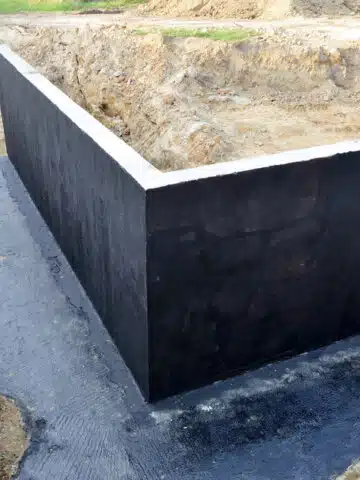Blog
Foundation Waterproofing: Debunking Common Myths
In the vast world of commercial construction services, few topics generate as much discussion and debate as foundation waterproofing. With the integrity of large scale structures at stake, it’s understandable why this subject is of paramount importance. However, amidst the plethora of information available, several foundation waterproofing myths have surfaced, often leading to misconceptions and misguided decisions. This article aims to set the record straight by debunking some of these prevalent myths.
Waterproofing Isn’t Necessary for New Foundations
One of the most pervasive myths in the realm of foundation care is the idea that fresh, newly laid foundations inherently possess an immunity against moisture and water infiltration. Many believe that the robustness and unblemished state of new concrete automatically ensure its resistance to moisture threats. But this is far from the truth. Even the newest, most impeccably crafted foundations can have vulnerabilities that become potential gateways for moisture.
Environmental factors play a critical role in this. As the foundation is exposed to varying weather conditions, it experiences temperature induced expansions and contractions. These can lead to microcracks, often invisible to the naked eye. Additionally, the pressure from surrounding soil, especially during rainy seasons, can cause unexpected stresses on the foundation. As the building and its foundation settle over time, these pressures can lead to more pronounced cracks or shifts.
It’s precisely for these reasons that proactive waterproofing, even for the newest of foundations, becomes indispensable. By addressing potential vulnerabilities from the onset, property owners can stave off moisture related issues in the future. It’s a proactive step that ensures the foundation remains in optimal condition, safeguarding the structural integrity of the entire building.
All Waterproofing Methods are Essentially the Same
This myth is particularly dangerous because it oversimplifies a complex subject. At a glance, one might believe that any waterproofing measure, as long as it repels water, should suffice. However, the world of foundation waterproofing is vast and varied, with each method tailored for specific scenarios and needs.
For starters, sealants, often used as a quick fix solution, work by plugging pores and preventing minor moisture intrusion. But their effectiveness can be limited, especially when dealing with significant water pressure or larger cracks. On the other hand, drainage systems, designed to divert water away from the foundation, are great for areas prone to heavy rainfall or flooding but might be overkill for drier regions.
Then, there’s the comprehensive approach of exterior waterproofing membranes. These are meticulously applied to the foundation’s exterior, creating a robust barrier against moisture. This method, while effective, requires excavation and is generally more labor intensive, making it a pricier option.
The differences between these methods highlight the importance of professional consultation. Property owners seeking commercial construction services need to understand that there’s no one size fits all solution.
Interior Waterproofing is Merely a Temporary Solution
Some critics argue that interior waterproofing is just a band aid fix, addressing symptoms rather than root causes. While it’s true that interior methods focus on managing water that enters the foundation, this doesn’t mean they’re merely temporary. When correctly implemented, interior waterproofing can offer long term protection, especially in scenarios where exterior interventions aren’t feasible or cost effective.
Waterproofing Can Be Effectively Done DIY
In today’s age of DIY tutorials and online guides, some believe that foundation waterproofing is a task they can tackle independently. While certain minor waterproofing tasks can be done DIY, ensuring a foundation’s comprehensive protection requires specialized knowledge and tools. Incorrectly applied waterproofing can lead to more severe problems down the line, making professional consultation and intervention vital.
Once Waterproofed, a Foundation Never Needs Attention Again
A foundation, once waterproofed, isn’t set for life. Some believe that once the foundation is waterproofed, it becomes immune to all future water related issues. However, like all aspects of a building, waterproofing systems can wear out, get damaged, or become less effective over time. Periodic inspections and potential touchups are essential to ensure continued protection.
Waterproofing is Too Expensive and Not Worth the Investment
Cost concerns often deter individuals from investing in through foundation waterproofing. While it’s true that some methods, especially comprehensive exterior solutions, can be pricier, it’s essential to view this as a long term investment. The costs associated with fixing water damaged structures or addressing mold and mildew growth can be significantly higher than proactive waterproofing. Ensuring a foundation’s protection can save substantial amounts in potential repairs and maintain a property’s value.
When navigating the intricacies of foundation waterproofing, it’s crucial to separate fact from fiction. By understanding the reality behind these myths, those engaged in commercial construction services can make informed decisions, ensuring that their structures stand strong and moisture free for years to come.





